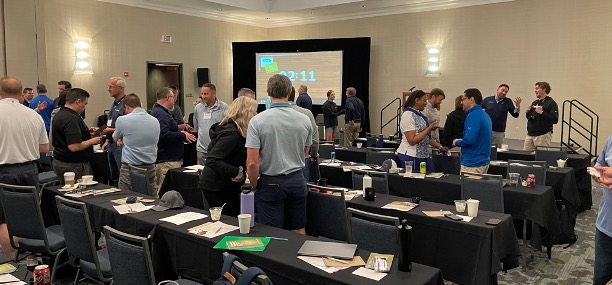Unleash Your Team’s Potential through Thoughtful Problem-Solving
Effective leadership isn’t just about solving problems;
it’s about solving them wisely.
When a problem arises, the best leaders don’t rush to fix it. Instead, they take a moment to sit with it, understanding its nuances and engaging their team in the solution process.
This approach not only leads to better outcomes but also empowers and engages the team with collaboration, leveraging their unique skills and perspectives.
Understand the Value of Patience in Problem-Solving
Rushing to solve problems can lead to hasty decisions, overlooked details, and missed opportunities for team involvement.
As a leadership coach for many years, I have often advised managers to take the time to sit with a problem and involving your team, you ensure a more thorough and effective solution.

Here’s how you can apply this principle:
Step 1: Identify the Problem and Sit with It
When a problem is identified, resist the urge to jump to a solution. Take a step back and fully understand the issue.
- What are the underlying causes?
- What are the potential impacts?
This initial patience allows you to gain clarity and prepare for a more strategic approach.
Step 2: Make “Two Lists of Three”
LIST 1: What are 3 things that I think could fix it?
- Evaluate Current Processes: Look at the current processes and identify any inefficiencies or bottlenecks. Sometimes, the problem lies in the way things are done rather than in external factors.
- Upgrade Tools and Resources: Ensure that your team has the right tools and resources to perform their tasks efficiently. Outdated or inadequate tools can be a significant hindrance.
- Provide Needed Training: Lack of skills or knowledge can often be the root cause of problems. Offering targeted training can empower your team to handle challenges more effectively.
LIST 2: Who are 3 people that I think could fix it?
- A Team Member Close to the Problem: This person has firsthand experience and insights that are invaluable in understanding and addressing the issue.
- A Cross-Functional Colleague: Someone from a different department can offer a fresh perspective and innovative solutions that you might not have considered.
- An External Coach or Peer: Bringing in an outside expert can provide an objective viewpoint and specialized expertise that your team may lack.
Step 3: Ask for 3 Possible Solution Ideas from Each
Before rushing to implement one of your ideas, seek input from these individuals. Ask each person for three ideas on how to fix the problem.
This not only gathers diverse perspectives but also fosters a collaborative environment where everyone feels valued and invested in the outcome.
Give the people you reach out to a time for when you need their insights so you can consider other perspectives and make a decision to move forward based on their input.
Then thank them for their thoughtful suggestions!
Step 4: Evaluate and Choose the Best Course of Action
Consider the input and suggestions from your team members. Evaluate their ideas based on feasibility, impact, and alignment with your organization’s goals.
The best solution isn’t always the one that you thought of initially. Sometimes it isn’t even the most logical solution.
We live in a world where two or more right answers can exist –
So what is the most time or cost effective option? Which one will be the most efficient or have the most positive impact on team morale and performance?
This process ensures that the chosen solution is well-rounded and robust.
Step 5: Delegate and Implement
Once you’ve selected the best course of action, delegate tasks effectively to those who need to be involved in implementing the solution.
Clear communication and defined roles are crucial here to ensure everyone understands their responsibilities and timelines – that is the value of team building events and developing strong relationships and trust.
Only when you know your team’s strengths, personality types, and ambitions can you best delegate tasks and implement plans with people in the right seats on your bus…

Case Study: Turning a Challenge into an Opportunity
Let’s consider a practical example.
Imagine your company is facing a significant drop in customer satisfaction. Instead of immediately overhauling the customer service department, you decide to sit with the problem and gather insights.
- Evaluate Current Processes: You discover that the current feedback system is outdated and slow, leading to delayed responses and unresolved issues.
- Upgrade Tools and Resources: Your team suggests implementing a new customer relationship management (CRM) system to streamline communication and track customer interactions more effectively.
- Provide Needed Training: It becomes clear that the customer service team needs additional training in conflict resolution and effective communication.
Next, you identify three key people to provide input:
- A senior customer service representative: They offer three practical ideas based on daily interactions with customers.
- A marketing team member: They suggest innovative ways to engage with customers and improve satisfaction.
- An external customer service executive: They provide an objective analysis and recommend best practices from industry leaders.
After gathering and evaluating their ideas, you decide to:
- Implement the new CRM system.
- Develop a comprehensive training program for the customer service team.
- Launch a customer feedback initiative to continuously gather and act on customer insights.
By involving your team and taking a thoughtful approach, you not only solve the problem but also enhance your organization’s overall customer service strategy.

Collaboration is The Key to Problem Solving
The essence of effective leadership lies in engaging your team and leveraging their diverse skills and perspectives. By involving them in problem-solving, you create a culture of collaboration, innovation, and shared ownership. Here’s how you can foster this environment:
- Encourage Open Communication: Create a safe space where team members feel comfortable sharing their ideas and feedback. Open communication leads to better understanding and more effective solutions.
- Recognize and Value Contributions: Acknowledge the efforts and contributions of your team members. Recognition boosts morale and motivates them to continue contributing their best ideas.
- Provide Opportunities for Growth: Invest in your team’s development through training, mentorship, and new challenges. Growth opportunities enhance their skills and prepare them for future leadership roles.
Patience and Collaboration Lead to Team Success
It’s tempting to rush into solving problems.
However, taking the time to sit with a problem, involve your team, and thoughtfully consider all options leads to better outcomes and a more engaged workforce.
Effective leaders understand that the best solutions come from collaboration and leveraging the unique strengths of their team.
If you’re ready to elevate your leadership skills and create a more dynamic and effective team, contact Sean Glaze.
As an experienced and interactive teamwork speaker and facilitator, Sean can help make your next professional development day a memorable and impactful success. Reach out today and start your journey toward more strategic and collaborative leadership.
– – – – –

Sean Glaze is an engaging team building speaker and interactive facilitator who helps organizations develop more effective leaders and build more positive and profitable workplace cultures.
Sean is the author of four books, The Unexpected Leader, Rapid Teamwork, The 10 Commandments of Winning Teammates, and Staying Coachable – each one an entertaining parable with powerful take-aways for team growth and leadership!
What issues are YOU dealing with that would disappear if you could build an exceptional team culture that inspired connection, accountability, and a team-first attitude?

Use Connection Chats to Engineer Better Collaboration Across Every Division on Your Team

Effective Leaders Build Trust and Teamwork by Focusing on Leadership Development

The Power of a Sticky Culture in Boosting Organizational Performance and Retention

Are Your Team Standards Seen as Suggestions or Recognized as Requirements?
Books and Resources for Leaders
Check other blog
Use Connection Chats to Engineer Better Collaboration Across Every Division on Your Team
Effective Leaders Build Trust and Teamwork by Focusing on Leadership Development
The Power of a Sticky Culture in Boosting Organizational Performance and Retention
Contact Sean

Connect with Sean

Tell Sean About
Your Event
Tell Sean About
Your Event
"*" indicates required fields











